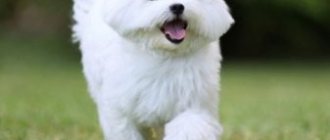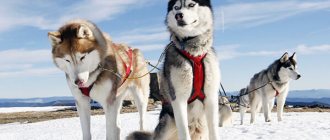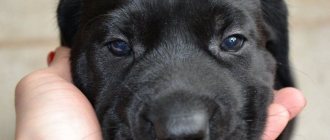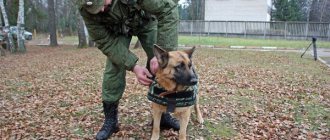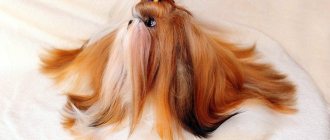The Basenji or Congo Terrier is one of the oldest dog breeds. She is one of the few that appeared without human intervention. The main feature is that the dogs hardly bark. Communicates with Basenji humans using snorts, sighs and other quiet sounds. This is a born hunter, a faithful companion to an active owner. This unique dog has many advantages. But this does not mean that he is better than other pets. The Basenji has a complex character, an independent disposition and an active temperament. Not everyone can cope with raising such an animal. Therefore, you need to study the description of the breed, the pros and cons, and reviews of the owners. Photos show what a Basenji looks like:
- Breed standard
- Education and training
- Feeding
Breed traits
Breed traits (on a 5-point scale)
| Basenji | |||
| Activity | in the house | 3.7 | |
| on the street | 4.4 | ||
| Obedience | training | 2.7 | |
| strangers | 3.6 | ||
| Domination | in family | 3.2 | |
| over dogs | 3.5 | ||
| Defending your territory | from people | 2.7 | |
| from dogs | 3.3 | ||
| Sociability | in family | 4.3 | |
| with strangers | 2.6 | ||
| with dogs | 3.4 | ||
| Concentration | in family | 2.3 | |
| in front of strangers | 3.3 | ||
| with dogs | 2.4 | ||
| Aggressiveness | in family | 1.9 | |
| to strangers | 2.6 | ||
| to the dogs | 3.3 | ||
| to cats | 3.3 | ||
| Family behavior | calmness | 2.6 | |
| demand for affection | 3.7 | ||
| excitability | 3.4 | ||
| playfulness | 4.1 | ||
| excessive barking | 2 | ||
| behavioral breakdowns | 3.7 | ||
| Tolerance for children | up to 4 years | 2.6 | |
| over 4 years old | 3 | ||
| Institutional use | watchman | 3 | |
| bodyguard | 2.6 | ||
This breed is often compared to the following dog breeds: Jack Russell Terrier, Shiba Inu (Shiba Inu), Beagle, Miniature Pinscher (Miniature Pinscher), Cardigan Welsh Corgi.
General characteristics of the Basenji
Some dog breeders believe that the Basenji dog is ideal for keeping in an apartment. It is suitable for active people for whom silence and cleanliness in the house are important. These pets do not bark and do not smell like dogs. But in addition to calm behavior and ease of care, the Basenji has disadvantages. This is an ancient hunter, smart, independent and self-reliant. Sometimes dog handlers say that it is the Basenji who accepts a person into his pack, and not the person who gets a pet.
This breed is not suitable for inexperienced owners, as well as for those who need an obedient pet dog. Basenjis were not artificially bred, so they retained their ancient instincts and behavioral characteristics. Those who are captivated by the lack of barking and easy grooming may encounter other problems in keeping or training. The uniqueness of this dog is that the Basenji's bark is very high-pitched. It is easy to teach her to sing, she can grumble and make sounds similar to laughter. Many owners consider this a great advantage and teach their pets to “talk.” Several videos show the Basenji talking and singing:
Video: How a Basenji barks or the “Voice” command
Video: Basenji sings
Video: Talking Basenji
| Options | Characteristics |
| country of origin | Central Africa |
| group of breeds according to the ICF classification | Spitz |
| life expectancy | 13-16 years old |
| height | females 39-40 cm, males 41-43 cm |
| weight | females 9.5 kg, males 10-11 kg |
| aggressiveness | not aggressive, friendly |
| activity | average |
| need for care | low |
| training | complex |
pros
When the world learned about this breed, it became popular. For those who manage to properly raise a Basenji, he becomes a loyal friend, a devoted and intelligent companion. Representatives of the breed have many advantages:
- small size allows you to keep it in a small apartment;
- look beautiful;
- at home they behave very quietly and calmly;
- smart, quick-witted;
- not aggressive, treat people kindly;
- very clean, lick themselves like cats, do not require frequent bathing;
- there is no dog smell from the fur;
- easy care, almost no shedding, no allergies;
- well-developed hunting and guard qualities;
- hardly bark;
- healthy, with good care they live up to 16 years.
Minuses
But this breed is not easy to keep. Basenjis also have many disadvantages:
- very active, energetic, need high physical activity;
- inquisitive, often play pranks and misbehave;
- independent, stubborn, do not like to obey;
- they steal food, pick it up on the street;
- can run away, as the hunting instinct makes them chase everything that moves;
- do not get along well with pets and can be aggressive with other dogs;
- cannot tolerate cold or water; clothing is needed in damp and cold weather;
- are still quite rare, so purebred puppies are expensive.
Video about the pros and cons of the breed:
Video: Basenji: The Non-Barking Dog Not for the weak
Features of the Basenji breed
The popularity of this breed is explained by its unique qualities that cannot be found in other dogs. The following unusual characteristics can be noted:
- You can hardly hear barking from the Basenji, instead you hear rumbling, grumbling, snorting, grunting or howling;
- the special structure of the larynx allows them to produce sounds similar to Tyrolean yodel tunes;
- when the dog is interested in something, it rises on its hind legs and can stand for a long time;
- representatives of the breed do not like water, wash themselves, and are very clean;
- have cat-like habits, can climb trees, and can climb onto a table or cabinet at home;
- the developed hunting instinct cannot be brought under control, even professional training does not help - the Basenji will still run away if something attracts it;
- Research by scientists has determined that this dog is a genetic subspecies of the gray wolf;
- Dog experts consider the Basenji to be the smartest dog of all breeds, but the most difficult to train.
Possible diseases
African Basenjis live an average of 13 years. But, like many breeds of small dogs, they often develop various diseases. Some of them are transmitted genetically through pedigree, some as a result of poor nutrition and lack of vitamins in the body.
Basenji on a walk in autumn
The main diseases of this breed:
- Liver and kidney diseases. A fairly common phenomenon, characterized by frequent urination and does not appear in the early stages. If not treated in a timely manner, it is fatal and requires treatment for the entire life of the dog, as it is not curable.
- Digestive diseases such as gastritis and enteritis. Gastritis occurs when the puppy’s owner chooses the wrong diet.
- Eye diseases - retinal atrophy due to insufficient hygiene - a disease leading to blindness. Corneal thorn. Corneal dystrophy. Cataract
- Urolithiasis disease
- Diseases of skin tissue, such as inguinal and umbilical hernia. A fairly common occurrence that does not require surgical intervention if there are no complications.
- Diabetes. It is quite rare among Basenjis, but is inherited.
- Skeletal diseases - dwarfism, hip dysplasia, calcinosis.
In order for a dog to live a long, happy life, the owner must take care of his health. It is necessary to undergo monthly examinations and urine and blood tests. And also, do not forget to get all age-appropriate vaccinations indicated in your passport.
History of the origin of the breed
The Basenji breed is one of the oldest on Earth. Scientists believe that it appeared more than 6 thousand years ago. Many images and figurines of such dogs were found in ancient burials. The Basenji's homeland is Central Africa. People used them as hunters and highly valued them. After all, they ensured their survival by helping them get food and protecting them from predators. They were treated with respect, carried in their arms, hidden from the rain. They called it a “dog from the bush”, “jumping up and down.”
The natives valued these dogs because they did not bark and believed that they could protect against evil forces and witchcraft. The silence was explained by a legend, as if in ancient times the leader of one pack heard an important secret. In order not to spill the beans, he promised to remain silent. Since then, all representatives of the breed are non-barking dogs.
The breed was valued in Ancient Egypt; these dogs were revered, considered a talisman, buried with their owners and even mummified. The natives of Africa still use them as hunting animals. The breed has been protected since ancient times and was not shown to foreigners. Several times they tried to export dogs to Europe, but for the first time they appeared outside of Africa only at the beginning of the 20th century. These dogs were exhibited at the Berlin Zoo as exotic animals. Only in the 30-40s the breed began to be bred. The first standard appeared in the UK, and dogs spread around the world after they came to the USA.
The breed received several names: Congo terrier, Congolese bush dog, forest dog from the Congo. The dog began to be called an African Basenji in 1943, when it was registered with the AKC. At first it was classified as a hound, but according to modern classification the breed is classified as a Spitz-type. No other breeds were used in breeding, so the dogs have retained their appearance and habits since ancient times almost unchanged.
They became popular all over the world after the Second World War. Non-barking dogs won prizes at dog shows and were owned by members of the nobility and royal families. African Basenjis appeared in Russia only at the end of the 20th century. This is still the rarest and most unusual breed.
Description of the exterior of representatives of the Basenji breed
Compared to other hunting breeds, Congo Terriers look elegant. The physique is harmonious, graceful, lean. Their proud posture and elongated muzzle make them quite beautiful. Their appearance has the following features:
- slim physique;
- square body;
- aristocratic posture;
- Long neck;
- characteristic curly folds on the forehead;
- tail tightly curled into a double ring.
Breed standard
The current standard was adopted in 1964. The African Basenji belongs to the Spitz group, a section of primitive breeds. This is a small, strong, harmoniously built animal. The size of the Basenji is average, the height at the withers reaches 40-43 cm. Weight should be 9-11 kg, deviations are not allowed.
Head
The head is medium, long. The muzzle tapers evenly towards the nose, the stop is barely noticeable. The forehead is flat, with wrinkles. Scissor bite, thin lips. The eyes are dark, almond-shaped, obliquely set. The look is smart, attentive. The nostrils are medium size, black. The ears are set high and erect. Triangular, with sharp tips, directed forward.
Body type
The physique is harmonious, the body is square. The neck is long, strong, gracefully arched. Slightly widens towards the shoulders. The back is straight, the loin is short. The chest is deep, the ribs are slightly convex, the stomach is tucked. The tail is set high, curled in a double ring and lies on the back. The ischial tuberosities protrude strongly.
Limbs
The limbs are straight, long and muscular. The front ones are thin but strong. Shoulders are directed back, elbows pressed to the chest. Pasterns elongated, flexible. The hind legs are muscular, the hocks are low. The paws are compact, oval, with thick pads. The gait is confident and graceful. They gallop and move quickly and easily through mud and sand. Photos complement the description of the appearance of the Basenji:
Appearance
Appearance Basenji
Varieties
There are two varieties of dogs of this breed: plain and forest. They differ in height at the withers and habits. Plains are taller, lighter, more suitable for home keeping. The forest variety of the breed is also called pygmy. Size less than 40 cm, darker coat. Independent and self-reliant by nature.
Basenji coat and colors
The coat is short, shiny, thin. Fits well to the body, soft and silky to the touch. The breed standard allows several colors:
- red and white is the most common, sometimes called red and white;
- black and white Basenjis are very rare, black in the light has a reddish tint;
- tricolor - black as the main color, red and white as markings;
- brindle was recognized only in 2000 and is not allowed in all countries.
The color is required to be white, but it should not predominate. Markings on the chest, belly, paws, small spots on the nose and tip of the tail. Areas of a different color have clear boundaries. Brindle dogs should have well-defined black stripes. Individuals of saddleback, blue and fawn colors are not recognized as a standard and are not allowed for exhibitions. Photos of different colors of representatives of the breed:
Black and white Basenji
Tricolor Basenji
Tiger Basenji
Character of the Basenji breed
Basenjis are pack dogs that get along well with their relatives, but do not like other animals. Sociable, very smart, they can become a devoted friend and companion for a person. They choose the owner once, and they miss him very much. It is not recommended to leave Basenjis alone at home, especially during puppyhood. Prolonged loneliness can result in destructive behavior.
The Congo Terrier becomes attached to all family members. He loves to be the center of attention and demands to be played with. But he does not impose himself, although he is capable of being offended. This breed should be owned by someone who can pay enough attention to the pet, play and walk with it. Otherwise, the dog will grow up stubborn, uncontrollable and aggressive.
Basenjis are wary of strangers. They do not show aggression, but are able to fight back and protect the owner. Fearless, they can engage in battle with an opponent much larger and stronger than themselves. Relationships with children are difficult. The dog loves them, is ready to protect them as members of his pack, and supports them in games. But she can hardly tolerate pranks and rough treatment. These dogs have the following character traits:
- independent;
- independent;
- stubborn;
- affectionate;
- sociable;
- smart;
- fearless;
- active;
- good-natured;
- cheerful.
Education and training
Representatives of this breed are very intelligent, but they are difficult to train. Therefore, it is recommended only for experienced dog breeders to own one. Basenjis are independent, self-confident, and capable of making independent decisions. They understand words, know what their owner wants from them, but are in no hurry to carry out commands. This can be explained by the fact that since ancient times, dogs have become accustomed to obeying instincts and acting without human help. You can achieve obedience, but you need to find a common language with your pet and win his trust.
It is important to become a leader for the dog, only then will he respond to orders. You need to act patiently and kindly. It is impossible to force him to do anything. He will not do anything that is not interesting to him. Although these dogs are active and agile, it is impossible to teach them tricks or dog sports. Education must begin at an early age. Even the puppy shows autonomy and independence. Therefore, from the first day of his appearance in the house, you need to ensure that the basic commands are executed: “come to me”, “place”, “you can’t”, “sit”.
Must be kept on a leash while walking. Due to hunting instincts, the Basenji may chase a cat or bird or run out onto the road. In this state, he does not hear the owner’s commands. Therefore, first of all, you need to develop the ability to come on command and know your name. You also need to teach your pet to give food out of its mouth, let a person go forward, and give way. The dog must not sleep on the bed, growl and snap at its owner, or beg for food. When training, it is necessary to take into account the characteristics of the breed. Dog handlers give the following recommendations:
- you need to be fair, consistent and persistent;
- practice skills and commands regularly, regardless of the circumstances;
- always reward for correct behavior, do not skimp on praise and treats;
- the dog should like to be near the owner, you need to interest him;
- unacceptable behavior should be immediately punished, but physical force should not be used;
- The Basenji should not be bored; he needs physical activity and intellectual exercise.
The video will help you understand how to properly train these dogs and communicate with them:
Video: Basenji. Training and raising a dog
Key points in training
Basenjis enjoy training in the form of a game
Reward in the form of treats is also important for the dog. The dog may refuse to carry out monotonous and uninteresting commands. Being intelligent and independent, the dog will not tolerate violence or raising its voice. The main difficulty in training is establishing contact between the dog and the owner. If the right attitude is not developed, the dog will allow itself to show disobedience and may even growl at its owner. The relationship between your pet and other dogs should be properly built to prevent fights between animals.
Caring for Basenji Dogs
African dogs are heat-loving dogs, so they must live indoors in winter. But the ideal place to keep such a pet would be a country house with a large plot. The dog will be able to throw out his energy on it and run around to his heart's content. Without adequate exercise, Basenjis can exhibit destructive behavior in the home. You need to walk him a lot - at least 2-3 hours a day, let him off the leash only in deserted places, preferably in fenced areas. It is recommended to use a leash up to 8 m long, this will allow the dog to run around.
In winter and wet weather, your pet needs clothing. Caring for a Basenji is easy. The coat almost does not need to be combed - just go over it with a brush once a week. No bathing required either. Contaminated areas can be wiped with a damp towel, and paws can be washed after a walk. Basenjis are afraid of water and also have sensitive skin, so frequent bathing can be a problem. But these dogs are clean, they avoid dirt on the street, wash their eyes with their paws, and wash themselves. You need to check your ears and eyes and brush your teeth several times a week. If necessary, trim the claws every month, otherwise they will interfere with the dog’s walking.
Feeding
The health and well-being of your pet depends on proper diet. You can feed them natural food or dry food. It is important that the Basenji receives a sufficient amount of protein, vitamins and minerals with its food. They are picky eaters, so it is recommended to diversify their diet. You need to give your pet raw meat, pouring boiling water over it, offal, sea fish without bones. Choose lean meat varieties. The diet should include eggs, cereals, vegetables and fruits, herbs, and dairy products. You should not give fatty foods, salty and spicy foods, sweets, baked goods, smoked foods.
Representatives of this breed need to be fed twice a day. You should not overfeed, as Basenjis are prone to obesity. Clean water should always be available freely. If owners choose dry food, it should be at least premium class. Suitable options for active medium-sized breeds: Orijen, Applaws, Acana, Grandorf.
Health
Congo Terriers have strong immunity. If suitable conditions are created, they live 12-15 years. You just need to get vaccinated on time to protect against infectious diseases, treat your pet for parasites and regularly visit the veterinarian for preventive examinations. The health of these dogs is good, which is due to their natural origin. Congenital diseases are rare. Health problems are possible with age:
- Fanconi syndrome – kidney disease;
- intestinal pathology associated with malabsorption;
- hemolytic anemia;
- hypothyroidism;
- retinal atrophy and other eye diseases;
- hip dysplasia.
There are frequent cases of limb injuries, which is associated with high mobility. You must also remember that Basenjis love to pick up food from the ground. It is difficult to wean them off this, so the owner must be prepared to cope with poisoning or intestinal infection. To provide first aid to a dog, you need to keep medications such as potassium permanganate, Glauber's salt, and magnesia oxide at home.
Natalia, 39 years old (my little panty)
I have 2 Basenjis. It so happened that they came to me by accident: I bought one from a pet store, where the puppy had been sitting for six months, and bought the second from careless owners. I'm not particularly attached to animals, but I couldn't pass them by. Asya and Alisa have been living with me for several years now.
I live in a private house, so the girls have somewhere to run. However, a difficult childhood still makes itself felt: they are both cowardly. They are afraid of noise, especially thunderstorms. After it, my Basenjis leave puddles on the floor. They relieve themselves on the street, but not always. Sometimes you have to take them out 2 times in the morning, because the first time they just walk around and sniff the area, and an hour later they ask to go to the toilet.
Our whole family loves them very much, we forgive almost everything. Since Asya lived in a pet store for the first months of her life, she is now afraid to be alone. She follows Alice with her tail and even goes to bed only with her. It's fun to watch 2 Basenjis nestle in a small chair!
Asya and Alisa practically do not communicate with other animals. I have a mongrel living in my yard, a cat wandering around the house—that’s the most the girls get along with. Other animals cause them panic or anxiety. They pay almost no attention to strangers. Guests will be greeted and that's all.
I work a lot, but I always find time to prepare food for my dogs. I cook buckwheat or rice and add beef. From time to time I also give chicken. I don't trust dry food; it's easy for me to cook it myself. I try not to forget about vitamins, especially in winter.
How to buy a Basenji puppy
It is difficult to find a purebred Basenji puppy, since dogs are rare in our country. If you decide to get such a pet, you need to contact a good nursery. You can buy a dog inexpensively at the market or secondhand, but it is unlikely to be a purebred dog. The price of a real Basenji in Moscow starts from 30 thousand rubles. A puppy with deviations from the standard can be bought for 15-20 thousand. He will have a pedigree, but he will not be allowed to show or breed.
Puppies of this breed are for sale from 2 months. The only characteristic of the breed at this age can be the standard color and specific wrinkles on the forehead. The puppy must be well-fed, cheerful, and clean. The coat is smooth, shiny, eyes and ears are free of discharge. It is important to pay attention to the living conditions of the animals and the behavior of the parents. The photo shows what Basenji puppies should look like:
Basenji puppies
Basenji puppies
Interesting video about Basenji dogs and its features:
Video: All about Basenji dogs
The non-barking Basenji dog is a unique and difficult pet to keep. Suitable for an active, strong-willed person who can pay enough attention to her. With a beautiful appearance, proud bearing and independent character, this dog can become a faithful companion, but it will require patience and perseverance. She will not listen to a weak, insecure person.
Konstantin, 18 years old (useful information)
The whole family made the decision to get a Basenji. We have 2 cats, but we were not scared by the fact that the breed is a hunting one.
To avoid unpleasant situations, we also decided to train the dog with a dog handler.
Toby successfully completed the general training course. He gets along with cats, doesn't chase them, doesn't start fights. True, he sometimes pulls out on the street if he sees birds, but we are used to it.
Mom is a chef by profession and she cooks for Toby herself. Meat, cottage cheese, fruits, vegetables - she makes up the entire diet herself. She learned from the veterinarians that Toby needed vitamins. We bought him a special complex with useful substances. Mom is very afraid that due to a deficiency of vitamins, Toby will often get sick.
We spend at least 30 minutes with him outside. If possible, we walk for 1-1.5 hours. There is a dog park nearby, where we let him run around or, as his mother says, “to throw out his energy.” I bought a frisbee and balls for Toby, which I take to the playground. For autumn and winter, his mother sewed him suits. Toby is the family's main pet.
